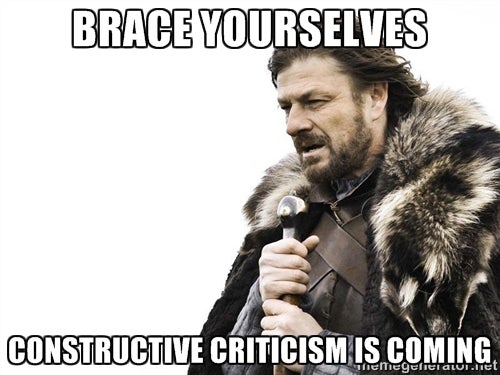Knowing you did something wrong is tough. Being called out on it can be even harsher. As students, however, feedback is something you often get. While we usually gloss over the positive feedback, when we face negative feedback we can become pretty defensive. And that’s natural. Your writing is something special that you created and thus when you receive criticism, it can seem like an attack on you. However, while some of this criticism can come across as demeaning or confidence shattering, there are usually helpful things to be taken from the notes your marker has left for you.

Admittedly, there is a fine line between constructive criticism and plain criticism. Simply writing that something is poorly or awkwardly written doesn’t tell the writer how they can improve. Instead, when pointing something out, it is much more helpful if it is accompanied by comments on why this is a mistake, why it was made, how to improve, and finally how to avoid it in the future. Here we have the crux of feedback. Without constructive criticism we will never be able to improve. There are many steps in the process of taking negative feedback to help you become a better student or writer and they are the following:
- Do not take the criticism personally. In the case of assignments or projects, the marker is not trying to berate you as a person, but instead usually wants you to improve as a writer. Just because a professor gave you a bad mark does not mean they dislike you. Your academic self is separate from your personal self.
- Identify what you did well first. It’s usually a good start to give yourself a confidence boost by acknowledging that you did do something right. Even if there is criticism of your work, you can still be a good writer. Once you’ve increased your self-confidence like this, you’ll be ready to face the other feedback.
- Carefully read what the marker has identified as you having done wrong for the assignment. If it helps you, take point form notes on general things they suggest (such as better word choice or cutting down on wordiness) for personal reference the next time you’re working on something. Sometimes, however, suggestions are not provided, so try to see what they wrote and think about how that can relate to specific writing conventions that you can improve on.
- Read over your writing again, keeping in mind the feedback you received. Thoroughly analyze your work and think about what you could’ve written instead to improve. The use of examples will help you identify the issue and then recognize it, should it come up again. Realizing also, that you might have missed the issue in the first place, will let you know if there’s something lacking in your editing process, whether that be that you should be proof-reading more carefully or that you should try reading aloud to try to catch more mistakes.
- Don’t sweat it. No masterpiece was created without a rough draft. JK Rowling’s Harry Potter was rejected twelve times before being published. Stephen King threw the first few pages of Carrie into the trash before his wife convinced him that there was something there. Mistakes are opportunities from which to learn from. The next time something comes up, you’ll be more prepared to tackle it.
